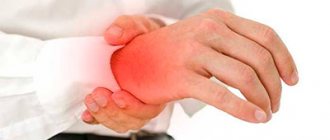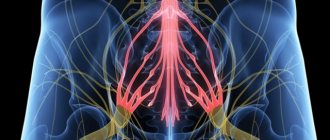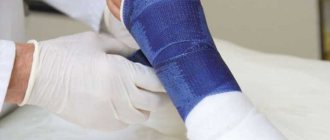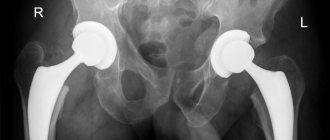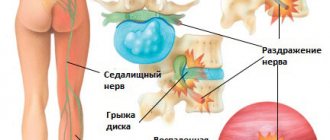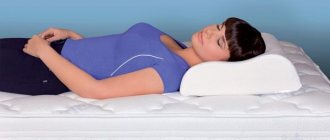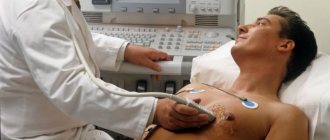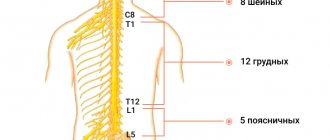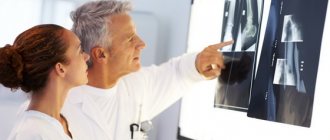Whiplash is a non-medical term used to describe neck pain following injury to the soft tissues of the neck (particularly the ligaments, tendons, and muscles). This injury occurs due to excessive forceful hyperextension followed by sharp flexion or sharp flexion followed by extension. Whiplash occurs in traffic accidents, sports, falls and fights. The term whiplash injury was first coined in 1928, and it continues to be used to describe this soft tissue injury to the neck.
The spine is a long column of bones, discs, ligaments and muscles that extends from the base of the skull to the tip of the tailbone. The cervical region supports the head, protects the nerves and spinal cord, and allows for the necessary amount of movement. The main supporting structure is the vertebrae. There is a disc between every two vertebrae. At the back of each vertebra there are two facet joints, one on each side. The joints are shaped to allow for smooth back-and-forth movement and rotation while limiting excessive movement. Muscles and ligaments surround and support the spine. All of these structures are innervated, and damage to any structure can cause pain.
Cause of pain
It is usually not possible to accurately determine the cause of neck pain until several days or weeks after a car accident. It is known that muscles and ligaments become stretched and likely become inflamed after an injury, but the condition usually resolves spontaneously within six to ten weeks. Pain that lasts longer is usually the result of more serious problems, such as disc or facet joint damage.
- Facet joint pain is the most common cause of chronic neck pain after a car accident. The pain may be limited to the facet joints or may be associated with disc pain. Facet pain is typically located to the right or left of the center of the back of the neck. The area may be tender to the touch, and facet pain may be mistaken for muscle pain. Unfortunately, it is difficult to determine whether facet joints are involved using X-rays or MRI. The only reliable way to confirm the role of the facet joints in pain is to perform a medial branch block.
- Disc injury from whiplash can also lead to chronic neck pain. The disc allows the neck to move, but at the same time keeps the neck from excessive movement. The outer part of the disc (called the annulus fibrosus) can be torn from a whiplash injury. Typically, this tear will heal, but not in all patients. In this case, the disc becomes weaker and leads to pain during normal activities. The pain comes from the nerve endings in the annulus fibrosus. The disc is the primary cause of chronic neck pain in 25% of patients, but the pain may be associated with facet joint pain. Disc herniation and compression of nerve roots appear much less frequently and, in such cases, pain in the arm prevails over pain in the neck.
- Strained muscles in the neck and upper back can cause severe pain. However, there is no conclusive evidence that neck muscles are the main cause of chronic neck pain. However, muscle damage can occur when muscles have to endure greater strain to protect damaged discs, joints, nerves, or when posture is poor.
- Compression of the roots and spinal cord by disc herniation or osteophytes is possible. This usually results in arm pain, but there may also be neck pain.
Ways to treat neck pain
In order to prescribe effective treatment, the doctor first prescribes diagnostic measures: a blood test, X-ray findings, CT or MRI readings as necessary. The main methods of combating diseases are the use of various painkillers, anti-inflammatory tablets and syrups, warming or cooling ointments, etc.
It is also necessary to undergo physiotherapeutic procedures (electrophoresis, magnetic therapy, classical and vibration massage of the neck and collar area; physical therapy and balneotherapy). The use of traditional medicine is allowed. Among all folk remedies, these folk recipes are considered the most effective.
| Ingredients | Recipe |
| Mustard seeds, aloe juice, vodka | Mix aloe juice and vodka in different proportions, adding a teaspoon of seeds. Make a compress and leave it overnight |
| Rye flour | Mix flour with water, adding a little sea salt. Make cakes and apply to the sore spot for several hours |
| Fresh leaves of coltsfoot, alder and burdock | Plants are finely chopped or ground in one container. Before going to bed, the paste is applied to the neck and wrapped in a scarf. It is recommended to carry out the procedure daily for 5-7 days |
| Grated potatoes and honey | 2 medium potatoes are grated on a fine grater and squeezed. Then add 1 tablespoon of liquid honey and mix. The resulting mass should be applied to a clean rag and applied to the outside of the neck for 2-3 hours. |
| Hop cones, pork fat (lard) | The hop cones are crushed and pushed around. Add pork fat to them in a 1:1 ratio and mix well. The resulting mixture is applied to the sore neck and left for 1.5 -2 hours. |
| Burdock root | Freshly dug burdock root is finely chopped and the resulting mass is poured with boiling water at the rate of 1 tablespoon per 1 glass of water. The solution should stand for at least 3-4 hours in a cool, dark place. The resulting infusion is taken orally in 100 g doses. after every meal |
| Laurel leaf oil | A few drops of bay oil are added to a liter of boiled warm water. Gauze is soaked in the solution and applied to the neck for 45-60 minutes. |
After a person wakes up and feels pain in the neck, there is no need to make any sudden movements in an attempt to alleviate his condition. Before using all the above recipes, you must first consult with a specialist. There are contraindications in the form of individual intolerance to the components, skin lesions in the required area, elevated body temperature, hypertension, neoplasms in the neck area.
Whiplash Symptoms
- Headaches caused by problems in the neck are called cervicogenic. These pains can be caused by damage to the upper cervical discs, facet joints, disorders of the atlantooccipital and atlantoaxial joints. Cervicogenic headaches can also aggravate migraines.
- Pain and heaviness in the arm can be caused by compression of the root by a herniated disc, which does not present diagnostic difficulties. More often, the pain in the arm is “reflected” from other parts of the neck. “Referred pain” is pain that is felt in an area located far from the injured areas, but is not associated with nerve compression. Pain between the shoulder blades is usually a type of referred pain.
- Low back pain is common after a whiplash injury and can be caused by damage to the discs, facet joints, or sacroiliac joints.
- Problems with concentration and memory may be related to pain or medications taken to relieve pain, depression, or a mild concussion. The patient may also experience irritability and depression.
- Sleep disturbance may be associated with pain or depression. Other symptoms may include: slight blurred vision, ringing in the ears, tingling in the face and fatigue.
Symptoms
The pain that occurs in people after sleep can be of a different nature: sharp or dull, aching or throbbing, shooting or stabbing, growing gradually or suddenly. This directly depends on the original cause of its occurrence.
Pain in the occipital part of the head and neck
In addition to the fact that patients suffer from pain after waking up, other unpleasant symptoms may appear:
- pain radiating to the ear, gum, temple, head;
- hyperemia and swelling of the affected area;
- loss of sensitivity, numbness, tingling;
- local increase in temperature (the affected area becomes hot to the touch);
- muscle fatigue;
- general weakness of the body;
- in severe forms of the disease - paralysis of the upper limbs.
Treatment in some cases is carried out not only conservatively, but also surgically
Diagnosis of whiplash injury
The attending physician needs information about the symptoms, how the injury (accident) occurred, and a medical examination. This will allow the medical professional to find out whether there is a need for diagnostic procedures or whether this can be waited. Patients whose symptoms persist for several weeks may require the following diagnostic tests:
- X-rays are prescribed immediately after injury if there is a suspicion of a fracture or instability of the spine. X-rays can also show the height of the discs and the presence of osteophytes.
- X-rays are also prescribed if symptoms persist several weeks after the injury.
- Magnetic resonance imaging (MRI) is a necessary examination for suspected disc herniation, disc injury, root or spinal cord compression.
- A medial branch block is an injection of anesthetic to diagnose facet pain.
- Discography involves the introduction of contrast into the disc and subsequent radiography, which is necessary only in cases of severe pain.
- Computed tomography (CT), usually in combination with a myelogram (contrast injected into the spinal canal), can also be used to diagnose persistent, treatment-resistant neck pain.
- Electromyography and nerve conduction velocity (EMG and ENG) measurements may be used if there is a suspicion that a nerve is blocked (for example, in carpal tunnel syndrome) or there is nerve damage.
Modern diagnostic methods
During the examination, the doctor will ask you about your symptoms, feel your neck to determine muscle tension and soreness, and ask you to turn and tilt your head to the right and left. A neurological examination will be carried out to help identify signs of other diseases that may have led to inflammation in the neck muscles.
After the examination, you will be prescribed an examination, which may include:
- Blood tests. They will help identify elevated levels of enzymes (such as creatine kinase), which will indicate inflammation in muscle tissue. Immunological tests will detect antibodies in autoimmune diseases.
- MRI. The pictures will show lesions in the muscles.
- Neck muscle biopsy. The doctor receives a piece of suspicious tissue and sends it to the laboratory for analysis.
These studies are not always necessary; the doctor prescribes them only for special indications.
Treatment for Whiplash
Treatment for whiplash injury includes:
- Immobilization is wearing an orthopedic collar for several days, which allows, in the acute period, to reduce the load on the muscles and other structures of the neck.
- Drug treatment. Taking anti-inflammatory drugs both internally and externally for several weeks helps reduce the inflammatory process and relieve pain. In addition, for prolonged pain, it is possible to prescribe antidepressants and muscle relaxants.
- Physiotherapy (electrophoresis, cryotherapy, ultrasound) can speed up regeneration and relieve the inflammatory process.
- Exercise therapy is prescribed after minimizing pain and allows you to restore normal biomechanics of the spine.
- Manual therapy and massage can relieve muscle blocks and muscle spasms.
- Blockades can also be used, but it must be taken into account that their effect is quite short-lived. It is also possible to use minimally invasive procedures, such as radiofrequency neurotomy, if the pain syndrome is persistent.
Surgical treatment is prescribed only if there is a violation of the integrity of the structures of the cervical spine and persistent symptoms resistant to treatment.
Why does cervical myositis occur?
There are different forms of the disease, they are caused by different reasons.
- Inflammatory diseases. Some diseases are characterized by chronic inflammatory processes in different parts of the body, including the neck muscles. They are usually caused by autoimmune conditions in which immune cells misbehave and attack their own tissues. For example, the neck muscles (but not them alone) can suffer from diseases such as dermatomyositis and polymyositis.
- Infectious diseases . The most common cause is viruses. Inflammation in muscle tissue can occur with flu and colds. Less commonly, pathogenic fungi and bacteria are the culprits.
- Taking certain medications . At the same time, inflammation is not always detected in the muscles (such conditions are called myopathies). The cause may be statins (medicines that are used to reduce the level of “harmful” cholesterol in the blood), alpha-interferon, etc.
- Poisoning. For example, alcohol, cocaine.
- Injuries . Injury to the neck muscles with subsequent development of the inflammatory process can occur as a result of too intense sports activities.
